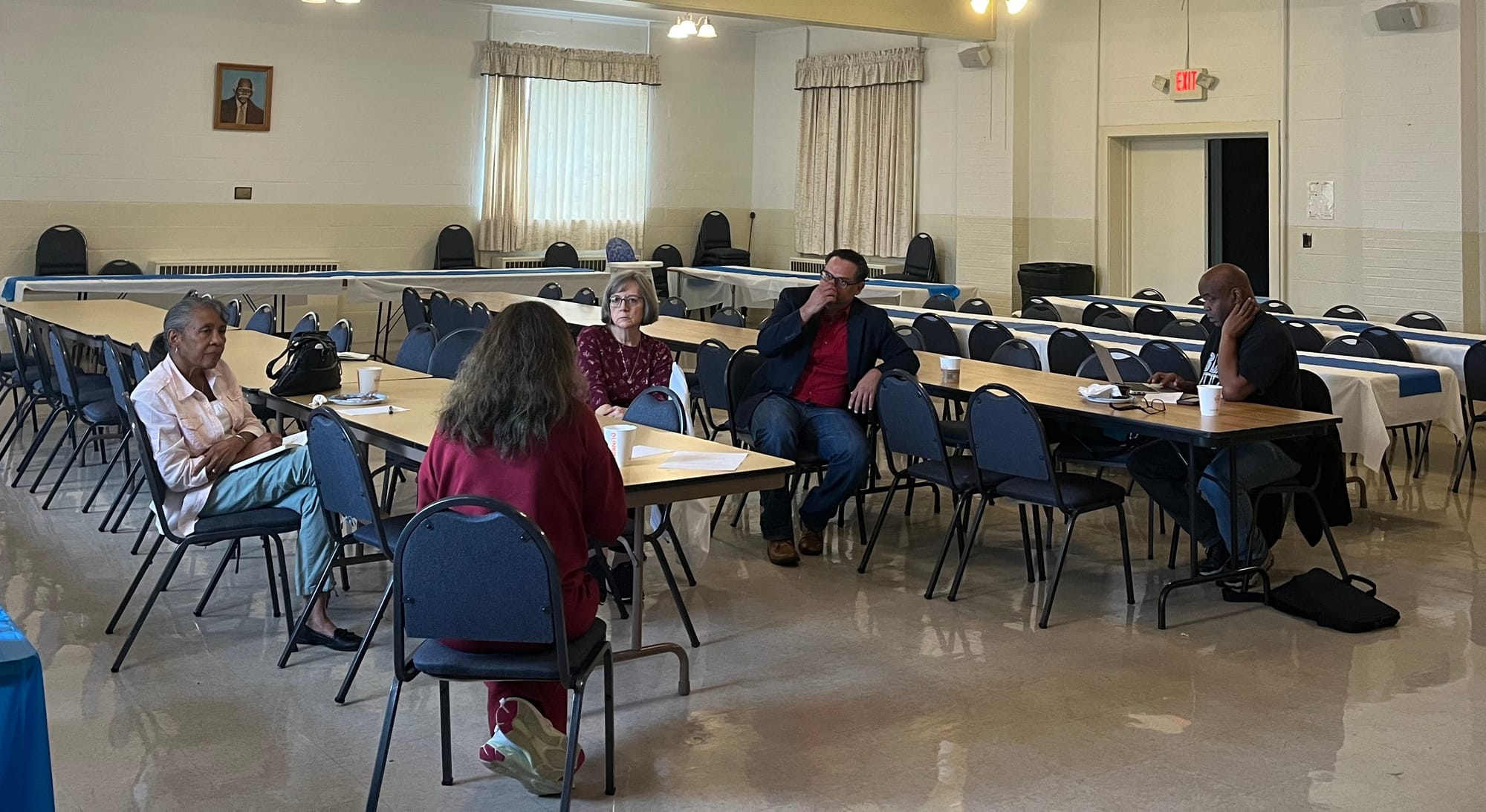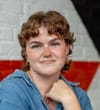Equity Board Grapples With Low Turnout On Proposed Apology
The board is hoping more will attend two upcoming meetings.

Just before 10 a.m. last Saturday, Angela Penn peered through the windows of Williams Memorial Baptist Church into the rainy morning. As chair of the Equity and Empowerment Advisory Board, Penn was prepared to lead a critical step in Roanoke’s reckoning with its past. Inside the church, long tables were arranged, dozens of chairs set in place and a welcoming spread of bagels, fruit, and juice laid out.
For nearly two years, the equity board has been working on Roanoke City’s apology for the decades of damage it inflicted through urban renewal. Between the 1950s and 1970s, the city’s urban renewal policies demolished Black homes and businesses in Gainsboro and Northeast to clear the way for new development. Earlier this month, the board voted to deliver a historic apology to city council, outlining the timeline of urban renewal and acknowledging the lasting harm it caused to Roanoke’s Black community.
Now, the board is seeking public feedback for a list of reparative action items, which would be sent to council following the acknowledgement. The council will have to vote on each matter. No dates are set for that.
Saturday’s session marked the first effort to gather community input. But as the minutes passed, only five seats were filled — by Penn, board member Juan Carlos Mejia, and three community members: JoAnn Hayden, Stephen Niamke and Nancy Morris. The city did not advertise the meeting.
Earlier this year, the city removed references to the equity board from the city’s website, following President Donald Trump’s executive order on “Ending Radical and Wasteful Government DEI Programs and Preferencing.” Along with the EEAB’s webpage, all diversity, equity and inclusion language was removed. Roanoke City’s official Facebook page — which previously promoted EEAB meetings — has not posted about the board this year. That has left the board in the position of operating covertly, without regular meeting notifications.
Moving forward, Penn said she hopes to work with the city to amplify outreach through its official communication channels and improve attendance at future sessions. Ahead of the meeting, Penn said she distributed information about the session via email to churches and tried to get a notice in The Roanoke Tribune.
The Roanoke Rambler asked Mayor Joe Cobb in an email Monday how the city has supported the EEAB in the urban renewal apology process. “Since the formation of the EEAB, created by City Council, we have worked to support their efforts in addressing matters of equity throughout the city.” Cobb wrote. “In fact, I was involved as early as 2019 in meeting with community leaders to discuss an apology and action steps. We worked with the EEAB to continue this process.”
In response to a question about the city’s plans for additional outreach support, Cobb listed the dates for the upcoming meetings, adding: “We are working with our community engagement team regarding opportunities to further share this information.”
Additional community sessions are set for Monday, Oct. 13 at Melrose Library and Thursday, Nov. 6 at Williams Memorial Baptist Church. Both meetings will begin at 5:30 p.m.
Small crowd, big conversation
Despite limited turnout, the Saturday meeting moved forward. Penn opened the conversation with a question: “In what ways do you still see or feel the effects of urban renewal in the community?”
Hayden, a Roanoke native born and raised in Northeast, responded first. Describing her childhood, she recalled the years before urban renewal, when she walked down Williamson Road, crossed Orange Ave., and headed into Gilmer Elementary School. That school — along with 1,600 homes, 24 churches and around 200 businesses — were eventually razed by the city.
Hayden said she was 13 when her family was forced to move west to the Melrose-Rugby area. She remembers childhood friends and neighbors being scattered.
“I was born in Burrell Memorial Hospital and I was taken home to 538 Georgia Ave., and that’s what I knew as home,” she said. “And all of a sudden, we had to move. It was traumatic.”
Niamke, a founder of Friends of Evans Spring who moved to Northwest Roanoke at 5 years old, was moved by Hayden’s memories.
“I'm really taken by your story,” he said. “I'm feeling it. For as many years as I've known you — I've never heard you tell your story like you just did.”
“At this moment when I think about being a citizen of Roanoke, I am embarrassed,” he continued. “I'm embarrassed to claim that.”
With Hayden’s firsthand account setting the tone, the group turned to ideas for city accountability. Morris, a member of the EEAB’s subcommittee on trust, directed the group’s attention to the Berglund Center — a city-owned venue built on land that once homed Black families and businesses.
“I just think if people come to the Berglund Center and walk that land, that they should realize where they are,” she said.
The group brainstormed several ideas for how the city could acknowledge the building’s history and provide restitution. Suggestions included a memorial or artwork acknowledging the land’s history, a statement of recognition ahead of every performance and a percent surcharge on ticket sales to create a reparations fund.
Another idea: rename the civic center to reflect community history. The facility’s naming rights are currently under review by City Manager Valmarie Turner.
After the meeting, Morris shared that she had hoped that the meeting would be better attended.
“I was hoping that there would be more people from the African American community present,” she said, “but I understand there’s challenges.”
Hayden first learned about the meeting directly from Penn at a prior event at the Gainsboro Library, and felt an “obligation” to share her experience of living through urban renewal. She suggested that low attendance might be attributed to a deep-rooted sense of mistrust.
“I think that some people feel like the city's not going to do anything about what happened during urban renewal to a lot of Black people,” she said. “And even in our Black community, I've heard people say that.”
Niamke said he was surprised by Saturday’s low turnout — he expected more people to show up. He heard about the meeting through word of mouth and wasn’t sure if it was a “lack of promotion or a lack of interest,” he said.
“I just don’t know what to make of it,” he sighed.
Despite the small group, Morris said the discussion was “very rich,” and that she was especially grateful for Hayden’s personal story guiding the way.
“Even JoAnn’s one voice sharing that story, and then listening to other people respond to it, is just so insightful about the experience of urban renewal — and maybe even the lack of current understanding about its impacts,” she said.
Looking ahead
In an interview after the meeting, Hayden said she felt anxious leading up to the session — just the thought of discussing the painful history made her “tense up.” But ultimately, she felt responsible for keeping her family’s story alive.
“Some people, right here in Roanoke still don't know about urban renewal,” she said in an interview after the meeting. “It needs to be told, it doesn't need to be just swept under the rug. It's still being felt in many African American families.”
Mejia agreed with the sentiment during the meeting, describing the process of community engagement as “memory rescue.”
“Roanoke City has to make a strong statement for everybody who lives here that this is how this city has been developed — acknowledging the bad things and making the good things what we represent what makes us proud,” he said.
After the meeting, Penn reflected on the conversation — and the turnout — as she packed up the table of leftover berries and yogurts.
“I'm happy that people came to share their stories today,” she said. “And I think that we need to switch our model to going where people are.”
Of the six current EEAB members, Penn said the group plans to attend meetings across the community — in addition to the previously established dates — to gather as much community feedback as possible for the apology’s second part.
“Really the important part of this isn't what any of [the board] has to say,” she said. “It's what community members say — it's what they want to see.”

